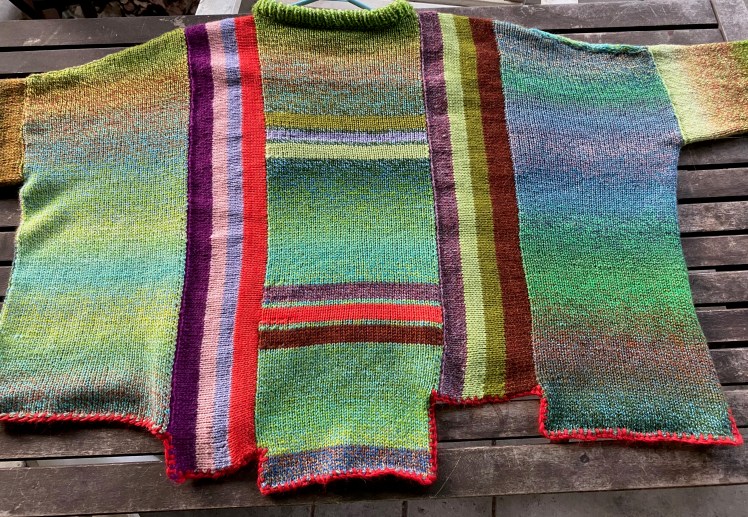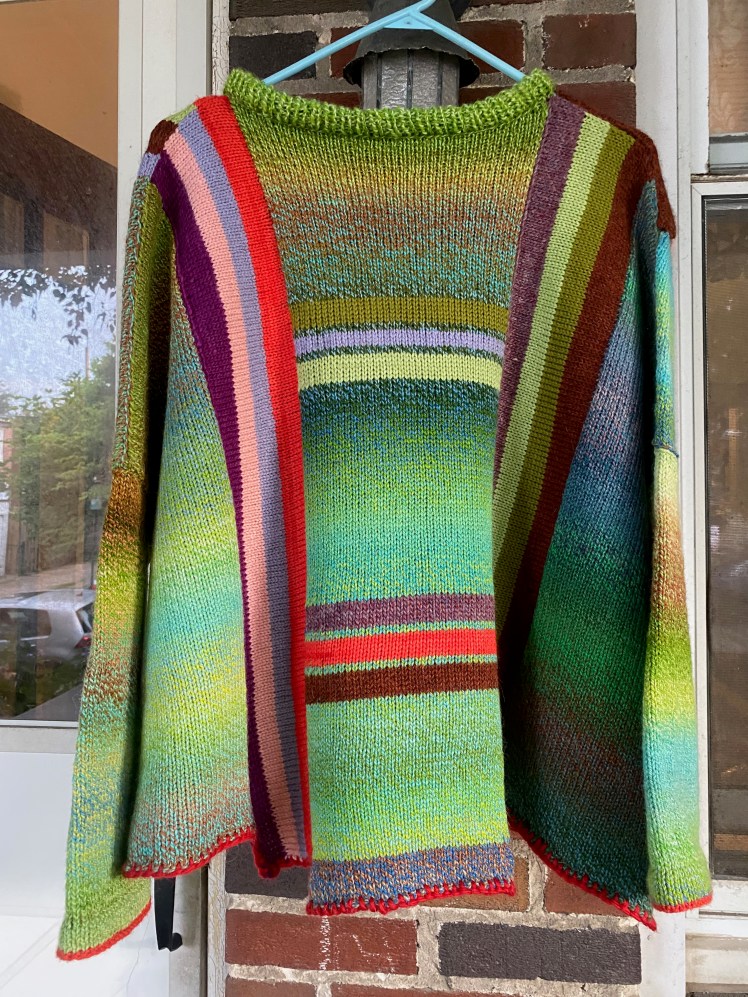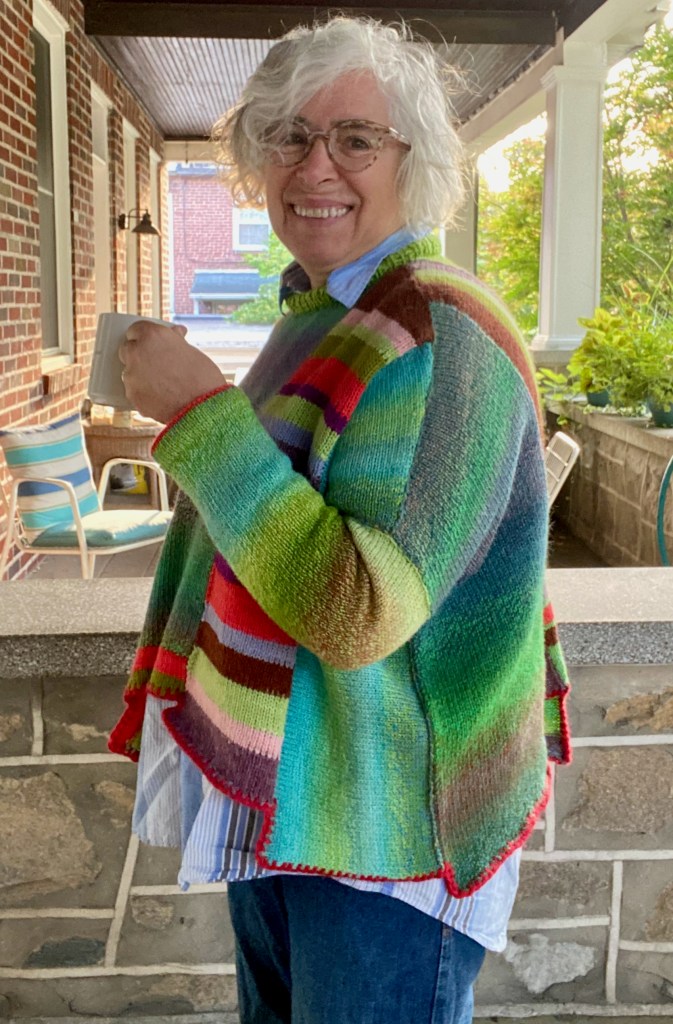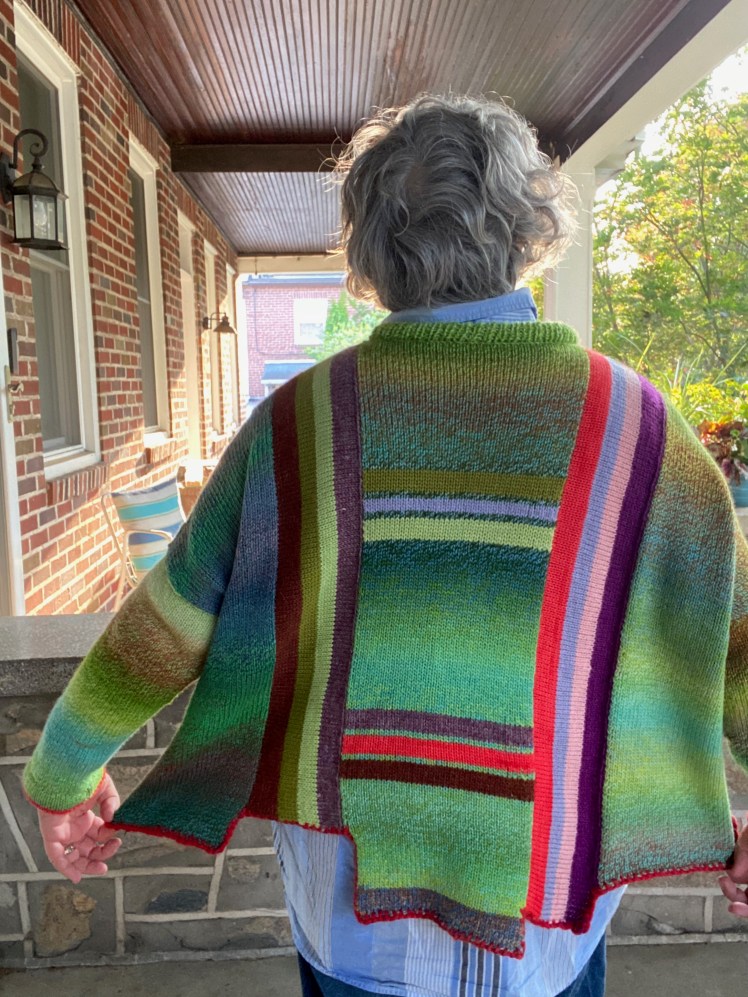When I got married decades ago, I was very tempted to get married the way my parents did when they were 22 and had no money, in a rabbi’s office with next to no guests, no catering, no band, nothing but the legal essentials. But I thought that I might be sorry later on if I didn’t have a wedding dress, guests, a meal, a band, so we did that and I hated every single second of my wedding day because it was stressful and the things we spent money on had no real meaning to me. After it was over, I turned to Charles and said, “Let’s take a suicide pact.” Fortunately being married is very different from getting married, and I only regret the wedding, not the marriage. I had a similar experience seven years ago when I bought my super-fancy KH965i knitting machine, which is capable of so much more than I will ever be capable of, because I was susceptible to the argument that this would be a machine I could grow into and would never have to regret being stuck with a simple machine without the bells and whistles.
When I brought the KH965i home, it stayed in the trunk of my car for six weeks because I was so terrified of it, and when I finally mustered the courage to set it up, things did not go smoothly. I recounted my travails in my blog post Scary New Toy. Eventually my machine and I came to love each other, but we both know that I don’t really need all its bells and whistles. The one thing I’m good at is finding interesting ways to use basic hand-manipulation techniques, and I could go for the rest of my creative life without ever even plugging in and turning on my machine. I am finally starting to use the electronics, but only to discover that the electronic mechanisms are malfunctioning because they are gunked up and in need of a cleaning, and I’m starting to learn how to do that, which is a sentence I never expected to write. Me??? Learning the maintenance of electronic machines? My KH965i is taking me on a surprising journey.
I love my KH965i, but no single machine will knit every yarn weight, so I’ve been thinking longingly about mid-gauge machines, but have refrained from buying one because I don’t have room in my house. But my daughter in Wisconsin does have room, and her partner hand-knits. I asked him if he might be theoretically interested in learning how to machine-knit, because I wanted to have a knitting machine available for my use when I’m visiting them and he could use it whenever I’m not. So I purchased a Silver Reed LK150 6.5 mm gauge machine and had it shipped to their house a couple of weeks before my recent visit there. They had opened the box when I got there, but we had to figure out where to set it up. The less-used side of their kitchen island was stable, long enough, and had a ledge that was right for affixing the clamps, so I followed the instructions and the diagrams, and 20 minutes later I had a machine that was ready to go.
So away we went, Zoe’s partner and I, taking turns to make a swatch using yarn that I had brought with me from my stash, some of it from my First Knitting Era in the 1980’s and 1990’s. I had a general plan for the yarn I brought, five skeins of green/blue and green/purple gradients in Feederbrook Farms DK and eight remnant cakes of leftover yarn. I would knit it modularly in bottom-to-top segments joined with side-to-side striped segments, with an irregular, asymmetric hem inspired by a knitter/spinner/dyer named Mechthild who I know from my Ravelry group, The Interior of My Brain. I made a point of not looking at Mechthild’s projects while I was conceiving this piece so that I could take a poorly remembered idea and do something original with it, and in fact, after I was done, I went back to Mechthild’s projects on Ravelry and saw that her work is very different from this pullover.
From the moment I took the LK150 out of the box and clamped it to my daughter’s counter ledge, I had a suspicion, and four rows into my first swatch, I knew for certain, that this was the machine I could have owned and used daily and never wished for anything more, because it’s simple and beautifully designed to do everything I want to do. It was so easy and intuitive and welcoming and unintimidating. Like my wedding, my first knitting machine was a choice based on the regrets of future me, when the essential me is lazy and easily flummoxed by complicated add-ons. Maybe next time I have to choose between something basic and something complicated, I’ll remember my wedding and my knitting machine and go for the basic option. And maybe that will be the time I regret it later. And probably the reason the LK150 was so easy and intuitive was because I had done these exact actions a million times on the much smaller needles of a 4.5 mm gauge machine and had learned to do them almost literally blind.
After all these years of restricting my machine knitting to thin yarns, it felt liberating to knit thicker yarn from ancient stash that would have jammed the KH965i. I had to remind myself not to anthropomorphize my KH965i and feel like I was cheating on it with the LK150. It’s an inanimate object, my rational self reminded me. Also during this visit, I learned fascinating things about the innards of Brother electronic knitting machines, when my friend Tanya, who lives in Madison, took me on a guided tour of a Brother electronic machine that she had disassembled in order to restore it to working order. I had seen videos of how the parts of the needle selection mechanism connect to knit programmed patterns, but the videos didn’t mean much to me until I saw the real parts in three dimensions. Tanya also showed me that it’s not difficult to disassemble the machine, not that many screws to keep track of, so when I got home, I did unscrew some of those screws (guarding the screws with my life), to get a look under the hood. Plenty of fluff underneath the cover and sticky yellow grease on the cam roller, and a solenoid armature that doesn’t want to move the way the others move. I have hope that a good cleaning will solve the mispatterning I’ve been experiencing when I use the preprogrammed Fair Isle patterns. Would I do this if I didn’t love my KH965i?

Our visit in Madison was a little over a week, and I wanted to get my project off the machine in time to give my daughter’s partner the opportunity to practice the basics of machine knitting while I was available for in-person consultation. I knitted while the two of them were at work during the day and knitted some more into the evening, and I knocked it out in five days. It took that long because my design required hand manipulation and math that I was working out as I went.

Here’s the front of the sweater. Its structure is a wide dropped-shoulder pullover knitted in five modular pieces for the front and another five modular pieces for the back, on a gauge of 5 stitches per inch and 7 rows per inch, with an irregular hem, each piece one to three inches longer or shorter at the bottom edge than the adjoining piece. The shoulders are shaped with short-rows or a stitch increased or decreased, depending on the direction of the knitting and the side of the body being knitted, placed an inch apart. That ratio might not have been completely identical between the vertical knitting and the horizontal knitting, because the vertical rows are shorter than the stitches are wide, at a 4:3 ratio. It looked as if the sloping was flatter for the vertically knitted pieces than for the horizontally knitted pieces. Since the row gauge was 7 rows to the inch, I think that next time I try this, I’ll do the increases/decreases by one stitch on the seventh row and the next on the sixth, alternately. That might get the same slope as the short row placed 5 stitches apart for the horizontally knitted pieces. But the discrepancy isn’t apparent when I’m wearing the finished garment.
The only seaming in this garment is at the shoulders, the sides of the sleeve seams, and the joining of the sleeves to the body. The body was formed modularly, with each new piece joined to its predecessor either by picking up edge stitches for the side-to-side knitting or by joining the horizontal knitting to the loops of the edge stitches on the side of the previous piece, at a 4:3 ratio if the piece was knitted side-to-side or every other row if the piece was also knitted horizontally. I started the knitting either above or below the bottom of the previous piece because I wanted the pieces to have an uneven square edge at the hem.
That required a little thought when I got to the final piece that closed the circle for the final back piece, which would be the piece where the back of the sleeve would be attached, and would require a shoulder slope to connect it to the shoulder slope of the piece on the back that I was joining it to. Meanwhile, I would be joining it to the front edge piece where the front of the sleeve would be attached, so I would need to stop joining the new piece to that edge at the exact place where the sleeve would be seamed. Also the start of the piece would be somewhere between the two adjoining pieces, so I couldn’t use their row counts to cue the place where I needed to stop joining the new knitting to the front piece, while continuing to join it to the back piece and starting the short rows for the shoulder slope at the exact place where it would flow into the slope of the adjoining piece. I did the math, I placed the markers. At first I did the math wrong and had to frog a bit, but I recalculated and got it right the second time.
Then I knocked out the sleeves really fast and got my knitting off the machine in time for Zoe’s partner to play with the machine a day or two before we had to go home. I showed him how to do the e-wrap cast-on, weight the bottom edge, and choose a tension, and in about 15 minutes, he had a foot of knitted fabric. That impressed him.
I was able to do some of the seaming for the sweater while we were still at my daughter’s house, but there was going to be a good bit of hand-finishing to do at home. Also a bit of frogging and reknitting one of the sleeves on Melissa’s bulky machine after I discovered that in my haste to finish the machine knitting, I had miscounted the cast-on for one of the sleeves and it was 10 stitches too narrow. I did it right the second time, and sewed in the sleeves. My plan to tame the stockinette curling at the hem pieces was to borrow the trick Junko Okamoto used for her Hana pattern by hand-sewing a decorative blanket stitch edge around the hem and then blocking the daylights out of it to flatten it. I hand-knitted a ribbed neckband that was long enough to fold over and attach to the inside of the neck by picking up loops at the base of the ribbing and binding off the loop together with the stitches of the ribbing.
Here are the front and back, on a hanger and lying flat.


The back:


But how does it look on a still-living body?






I’m back at home now, and my dear old KH965i is in active use with an intarsia summer top for my sister hanging from the needles. Next project is cleaning out its gunky needle selection guts, under the adult supervision of Melissa’s husband, who is familiar with machinery and 1980’s electronic technology. But I’m already getting ready for my next visit to my daughter by collecting worsted yarn from ancient stash for a striped raglan pullover that will probably take no more than about three days to knit as long as I come prepared with accurate numbers. I also want to try making plated fabrics, which is apparently possible by simply feeding one color in one yarn mast and the corresponding feeder and the other color in the other yarn mast and feeder. I have designs in mind!
Machine-knitters say that once you get comfortable with machine knitting, one machine is not enough. This is true, because every machine has its strengths and weaknesses, and no one machine can knit every kind of yarn. The only limitation would be having a place to put additional machines, although that doesn’t necessarily stop people from acquiring them, although it did stop me until I got my daughter and her partner to let me use their house as my overflow studio. But I’m already thinking about getting an LK150 that would live here in my house, even though I still don’t have room for it. It’s easy to put together and take apart… I could get a folding table…

Enjoyed seeing this project go together. The castellated hemline is really fun.
LikeLiked by 1 person
Thank you! Castellated? Like castles? I didn’t know this term!
LikeLiked by 1 person
“Castellated”? Yes, indeed! (I know a longtime member of the SCA who makes and sells tents and pavilions. That castellated trim flapping around the outer walls of a tent is a classic look).
LikeLiked by 1 person
Ahh, another great and colourful fun knit!! Love all your ideas!
LikeLiked by 1 person
Thank you!!!
LikeLike
Great sweater, and great background story. So often, it’s better to start with what we want now than to predict what we *might* want in some unpredictable future. Just get going, and what you want in later days will reveal itself when the time is ripe.
LikeLiked by 1 person
You’re right! Shouldn’t I know this by now?
LikeLike
Wow what an absolutely amazing sweater! I have sweater envy!
LikeLiked by 1 person
I’m blushing! Thank you!
LikeLiked by 1 person
You are a wonderful writer and story teller! This is a little gem of a piece. Of course, I love the sweater. The blanket stitch hem is just brilliant. I might incorporate that sometime.
LikeLiked by 1 person
Thank you so much, Tanya!!! I think I like being told I’m a good storyteller even more than I like being told I’m a good knitter!
LikeLike